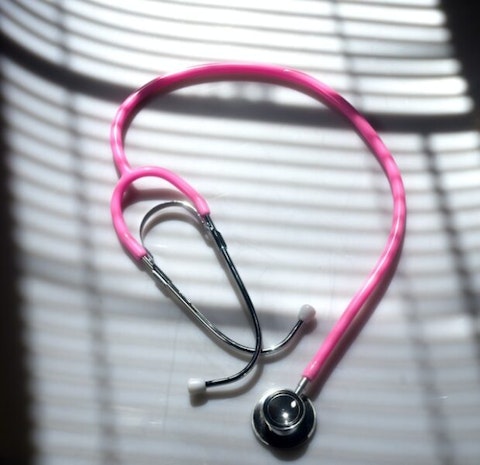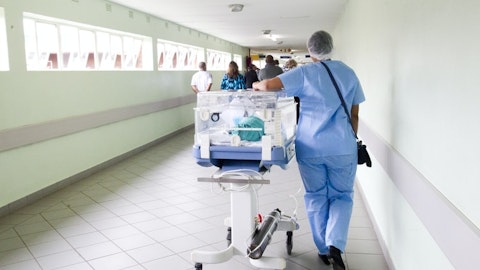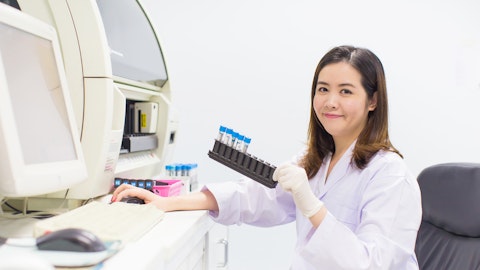Sensus Healthcare, Inc. (NASDAQ:SRTS) Q4 2022 Earnings Call Transcript February 9, 2023
Operator: Welcome to the Sensus Healthcare Fourth Quarter 2022 Earnings Conference Call. . Please also note that this event is being recorded today. I would now like to turn the conference over to Kim Golodetz with LHA Investor Relations. Please go ahead.
Kim Golodetz: Thank you. This is Kim Golodetz with LHA. Thank you all for participating in today’s call. Joining me from Sensus Healthcare are Joe Sardano, Chairman and Chief Executive Officer; Michael Sardano, President and General Counsel; and Javier Rampolla, Chief Financial Officer. As a reminder, some of the matters that will be discussed during today’s call contain forward-looking statements within the meaning of federal securities laws. All statements other than historical facts that address activities Sensus Healthcare assumes, plans, expects, believes, intends or anticipates and other similar expressions will, should or may occur in the future are forward-looking statements. The forward-looking statements are management’s beliefs based on currently available information as of the date of this conference call, February 9, 2023.
Sensus Healthcare undertakes no obligation to revise or update any forward-looking statements except as required by law. All forward-looking statements are subject to risks and uncertainties as described in the company’s Forms 10-K and 10-Q. During today’s conference call, references will be made to certain non-GAAP financial measures. Sensus believes these measures provide useful information for investors yet they should not be considered as a substitute for GAAP nor should they be viewed as a substitute for operating results determined in accordance with GAAP. A reconciliation of non-GAAP to GAAP results is included in today’s financial results press release. With that said, I’d like to turn the call over to Joe Sardano. Joe?
Joseph Sardano: Thank you, Kim, and good afternoon, everyone. I address you today with the highest of confidence that Sensus Healthcare is better positioned today than ever before in our history with all the pieces in place for even greater execution of our business plan. We believe our superficial radiation therapy technology remains the #1 choice for noninvasive treatment of skin cancer by both physicians and patients. Our improved reimbursement, combined with our fair market value lease program, provides our customers with an excellent patient acquisition tool, making the acquisition of our lead technology and easy transplant. Our new and improved high-resolution ultrasound technology provides see-and-treat capability, which leads to great outcomes and patient reassurances.
During the fourth quarter and throughout 2022, we strategically executed delivering strong revenue and profits. Importantly, we also took a number of steps to position Sensus for future success. These included assembling the staff and strategies to drive exceptional growth, building inventory, developing new aesthetic products that are anticipated to receive FDA clearance in the latter half of 2023, further investing in our Sentinel IT solutions capability and increasing sales and marketing programs, headcount and capabilities. As we’ve been saying for some time, with better reimbursement of superficial radiation therapy for non-melanoma skin cancer and lower reimbursement for Mohs surgery along with data suggesting that 1 in 5 Americans will develop skin cancer, we have powerful tailwinds to support our programs.
Recall that in January ’21, our SRT therapy received improved reimbursement from the centers for Medicare and Medicaid services when they revalued our main code upwards by 66% for a course of SRT in non-melanoma skin cancer. In addition, ancillary codes received a double-digit boost. We continue to capitalize on these reimbursement changes, and more and more practitioners are recognizing SRT as a best practice for the noninvasive treatment of non-melanoma skin cancer. Our rigorous physician education program, highlighting the improved return on investment for SRT is ongoing, especially at dermatology conferences and trade shows. In fact, this weekend at the important South Beach Symposium in Miami, a key opinion leader, Dr. Michael Gold, will be discussing SRT and its benefits.
This will be followed up 2 weeks later at the Winter Clinical Conference in Miami by another key opinion leader, Dr. Mark Nestor. We recently launched important upgrades to this system, including new state-of-the-art, solid-state, high-frequency ultrasound, which provides the industry’s best view of the epidermis and utilizes a new ergonomic design probe with single-use disposables. This upgrade system is garnering interest among physicians and the SRT-100 Vision has become our leading SRT product. The fair market value lease program we launched earlier last year continues to support purchases of our feature-rich SRT-100 Vision system, and its percentage of system sales continues to increase. While we are maintaining focus on our core dermatology business and providing products our customers need and want, radiation oncology is another important avenue for growth.
We’re gaining awareness among radiation oncologists and recently sold an SRT-100+ system to a large luminary hospital in the Northeast. And with that overview, I’d like to turn the call over to Michael Sardano for a bit more color on the quarter.
Michael Sardano: Thanks, Joe. We’ve been executing extremely well as evidenced by record high revenues for both the fourth quarter and the full year. We expect continued top line momentum in 2023 and beyond from our unique line of superficial radiation therapy devices, which will continue to lead our revenue growth throughout the coming years. We expect the recently acquired aesthetic devices to materially add to our revenue in the latter part of 2023 as we advance through the regulatory process. Additionally, we now have a dedicated and experienced aesthetic sales professional to manage this part of our business. During the fourth quarter, we shipped 36 SRT units, of which 27 were the SRT-100 Vision. Despite higher interest rates, our fair market value lease program continues to draw interest as an efficient way to acquire our devices.
Our international business is also doing well as we shipped a record 16 units during the 2022 and 6 during the fourth quarter, most of which went to Asia. We are concentrating on opening new markets in Latin America, Australia and the EU. So we have enormous potential outside the United States. With that, I’ll turn the call over to Javier Rampolla for a discussion of our financial results.

Photo by Christopher Boswell on Unsplash
Javier Rampolla: Thanks, Michael. It is a pleasure to be speaking with all of you this afternoon. Our revenues for the fourth quarter of 2022 were $13.1 million and this compares with revenues of $13 million for the fourth quarter of 2021. Gross profit for the fourth quarter of 2022 was $8.4 million or 63.7% of revenue compared with $8.9 million or 68% of revenues for the fourth quarter of 2021. The decrease was primarily driven by the higher manufacturing costs in 2022, all due to inflationary pressures, yet our gross margin remains in our target range of the mid-6s percentage. Selling and marketing expense for the fourth quarter of 2022 was $1.6 million compared with $1.3 million for the fourth quarter of 2021. The increase was attributable to higher advertising expense and higher compensation expense due to increased headcount.
General and administrative expense for the fourth quarter of 2022 was $1.4 million compared with $1.1 million for the fourth quarter of 2021. The increase was primarily due to higher professional fees along with higher compensation and bad debt expense. Research and development expense for the fourth quarter of 2022 was $1.2 million, unchanged from the current year quarter. We expect R&D expense to remain at this general level each quarter of 2023. We recorded a provision for income tax in the fourth quarter of 2022 of $1.6 million as we had no such provision in the fourth quarter of last year. Net income for the fourth quarter of 2022 was $2.8 million or $0.17 per diluted share and this compares with net income of $5.3 million or $0.32 per diluted share for the fourth quarter of 2021.
The decline was largely attributable to the income tax in 2022, and to a lesser extent, increase in cost of goods. Adjusted EBITDA, which we define as earnings before interest, taxes, depreciation, amortization and stock compensation expense was $4.3 million for the 2022 fourth quarter compared with $5.6 million a year ago. Turning briefly to full year financial results. Revenues for 2022 were $44.5 million compared with $27 million for 2021. The 65% increase was driven by a higher number of unit sold in 2022 due to the increase in demand. Cost of sales for 2022 were $14.9 million compared with $10.1 million for 2021, with an increase reflecting the higher number of units sold. Gross profit for 2022 was $29.6 million or 66.5% of revenue compared with $17 million or 62.8% of revenue for 2021.
The increases were driven by a higher number of units sold in 2022 and service revenue on installed units. Selling and marketing expense for 2022 was $6.3 million compared with $4.8 million for 2021. The increase was primarily attributable to higher spending on marketing activities and increase in headcount. General and administrative expense for 2022 was $5 million compared with $4.6 million for 2021. The increase was primarily due to higher compensation and bad debt expense. Research and development expense for 2022 was $3.5 million compared with $3.4 million for 2021. As I just indicated, we expect R&D expense in 2023 to be generally consistent with 2022. The company reported other income for 2022 of $13.2 million compared with $0.01 million for 2021.
The increase was mostly related to a gain on the sale of a noncore asset. Net income for 2022 was $24.2 million or $1.46 per diluted share compared with $4.1 million or $0.25 per diluted share in 2021. Net income for 2022, excluding a gain on the sale of a noncore asset, was $11.5 million or $0.69 per diluted share. Adjusted EBITDA for 2022 was $28.1 million compared with $5.1 million for 2021. Turning now to our balance sheet. Cash and cash equivalents were $25.5 million as of December 31, 2022, compared with $14.5 million as of December 31, 2021. The company had no outstanding borrowings under its revolving line of credit as of December 31, 2022 or 2021. In preparation for the future growth , we placed orders for inventories. We stood at $3.5 million in inventory and $6.3 million in prepaid as of December 31, 2022, up from $1.8 million in inventory and $1.9 million in prepaid a year ago.
Accounts receivables were $17.3 million, up from $12.1 million on December 31, 2021, reflecting the increase in sales. I’ll underscore what we have been saying for some time. Our attention to expense management is front and center, and we continue to be in a stronger financial position in the company’s history. Our balance sheet positions us well to take advantage of the compelling growth opportunity we may come across. As a final comment, please see the table in the news release we issued earlier today for a reconciliation of GAAP to non-GAAP financial measures. With that, I’ll turn the call back over to Joe.
Joseph Sardano: Thanks, Javier and Michael. As Javier just said, Sensus Healthcare has never been in a better position to meet the challenges of the future. We are well capitalized and have business momentum. In addition, we’re very excited about the portfolio lineup we have planned for later this year, and especially, in 2024, along with future enhancements to our SRT-100 Vision and Sentinel IT Solutions software. Sentinel is a proprietary HIPAA-compliant software solution and is available on all our new products. It allows physicians to easily and accurately document and store patient data for clinical billing and asset management purposes. This technology has been a game changer for our SRT customers and for Sensus as it clearly demonstrates the attractive ROI for the SRT-100 Vision and the SRT-100+ systems.
A priority focus for Sensus is expanding the capabilities and indications of our Sentinel technology. Under the leadership of our newly promoted Chief Technical Officer, we have already doubled the number of engineers at Sensus to 6 as we work to include artificial intelligence and diagnostic capabilities in Sentinel. I want to add that our new lasers, including all 6 of our Sensus-branded aesthetic smart lasers, will have the Sentinel IT Solutions capability embedded in them. In recent months, this portfolio has expanded to include silk diode laser, a truly portable laser with a lightweight handpiece, super cold cooling tip and the highly repetition ring. The ability to blend wavelengths while emitting light vertically towards the skin increases efficiency by maintaining the density of the laser in the selected area, resulting in deeper and better penetration and more homogeneous energy distribution.
Importantly, the laser is sensitive to all skin types, making this laser removal available to everyone. We have showcased Silk at the Fall Clinical and will also showcase the Laser this weekend in our booth at the annual South Beach Symposium. While we’re very excited about the potential of Silk, we’re also excited about the new lasers we plan to introduce later this year and early next year once cleared by the FDA. We have stepped up our marketing as well. We’re pleased with the early success of our new digital advertising initiatives to increase patient awareness of SRT. Our Facebook page remains very active as we work to engage the public. We will continue to increase our SEO activity, which is resulting in many more patients visiting our website to learn about SRT treatment.
Our SRT systems are well positioned in a large and largely untapped market consisting of some 14,000 dermatologists and 1,000 Mohs surgeons in the U.S., representing more than 8,500 offices, not to mention a further 6,500 plastic surgeons and 5,500 radiation oncologists. Our systems provide a compelling alternative to surgery for millions of patients and arguably, the only solution to prevent the recurrence of keloids following surgical excision. In addition, skin cancer is a large and growing condition with estimates that 1 in 5 Americans will develop skin cancer during their lifetime. This tells us that nearly 70 million people will contract non-melanoma skin cancer in this country. So clearly, this is a need for our SRT systems both now and even more so in the future.
In summary, we have our strongest team ever in place to support our growth with thoughtful programs, efficiency and leadership. We are deploying capital to invest in Sensus, deploying and bringing in new technologies and adding to our sales force. As evidence of our enthusiasm for our future, we repurchased $3 million of our common stock through a share buyback program. With those comments, I thank you for your time and attention. And now operator, we’re ready to take questions.
See also 10 Best 3-Row SUVs in 2023 and 16 Most Valuable Cigarette Brands.
Q&A Session
Follow Sensus Healthcare Inc. (NASDAQ:SRTS)
Follow Sensus Healthcare Inc. (NASDAQ:SRTS)
Receive real-time insider trading and news alerts
Operator: . And our first question here will come from Ben Haynor with Alliance Global Partners.
Benjamin Haynor: First off, for me, on the 510(k) submissions that are going in this year offer aesthetic products, should we think about those all as lasers? Or are there other 510(k)s that will be going in? And any color on conditions that those might treat outside of the laser submissions.
Joseph Sardano: Ben, thanks for being on. Good to hear in your voice, and I appreciate the question. It’s going to be a variety of aesthetic products that are going to be submitted to the FDA products that we’ve been able to acquire this technology, and we’re excited for that offering. But I would tell you that it’s going to be a variety of various aesthetic products that are going to be unique to the market that is going to have a very, very nice niche into the marketplace.
Benjamin Haynor: Okay. And do you plan to let investors know about those upon submission? Or do you wait till approval or launch?
Joseph Sardano: I think that we want to try to wait until we get to the launch period. And it’s going to make sense because as we go through this process of getting the equipment ready as it’s going through all of its testing with the various regulatory people and assembling all that data, we have to get that to the FDA, which could take a little bit of time. But we’re expecting to submit either by the end of the first quarter or the middle of the second quarter, and since their 510(k)s, they usually result in a 90-day approval process. But as we get closer to that, I would say that we would be able to announce it to the world as it works with progress sometime around the American Academy of Dermatology meeting.
Benjamin Haynor: Okay. So stay tuned. Got it. And then on the — congrats luminary on the Northeast radiation oncology. What are your thoughts on the kind of the sales cycle that these radiation oncology apartments will require and kind of initial level of interest? Any color you could provide there.
Joseph Sardano: Yes. The hospital market is a very difficult market, and I describe it as when they — when everybody at the hospital says, yes, we want to buy it, it could take up to 12 to 14 to 16 months, 18 months before you get a purchase order. So it’s a very long selling cycle. This — but we’re starting to see some hospitals that are requesting some quotes, if you will, for our system because there’s a lot more interest in that hospital market or in the radiation oncology market to get involved with skin cancer. And I think one of the reasons that we’re seeing that is that centers for Medicare and Medicaid services are working hard to reduce reimbursement in other areas of cancer. For instance, breast cancer, lung cancer, all of these cancers because they’re high-volume types of cancers with very high expense.
We’re starting to see reduction in those reimbursements across the line, and as those reductions happen, your hospitals are starting to look at additional sources of revenue. And if they’re looking over the fence, if you will, looking at greener , one of the things that they don’t have access to or have not accessed, whether it’s on purpose or not, is the skin cancer market. And when you look at skin cancer, it’s 4x greater than all the other cancers combined. So the acquisition of a technology like SRT is very minimal compared to the millions of dollars they spend on the radiation oncology products in those other areas yet the return on investment for them is very, very good and very strong. So I think that they see an additional cash positive opportunity in cancer, in an area that they’re not addressing.



